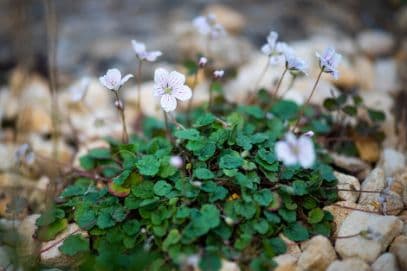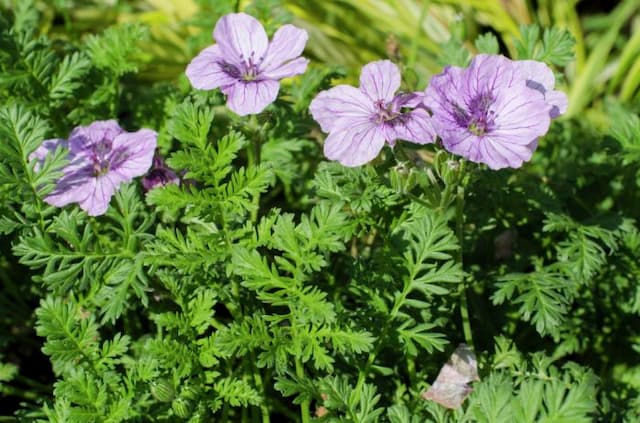Geranium Pelargonium 'Flamenca' (Z)

ABOUT
Pelargonium 'Flamenca', also commonly known as Geranium 'Flamenca', is a striking plant with an eye-catching appearance. Its foliage typically consists of bright green leaves that have a rounded shape with slightly lobed or serrated edges, often creating a lush, dense mound of foliage that acts as a backdrop to its flowers. The leaves can sometimes display zonal patterns of darker green, which adds depth and visual interest to the plant's overall presentation. The flowers are the most distinctive part of the Geranium 'Flamenca', bursting forth in vibrant shades that can range from vivid pinks to deep reds, often with intricate veining or streaking of contrasting hues which give the appearance of elegance and flamboyance. Each flower is structured with five petals, and they often form in clusters known as umbels atop sturdy stems that rise above the foliage, creating a delightful contrast between the greenery and the colorful blossoms. Depending on the specific variety of Geranium 'Flamenca', some may have flowers with subtle to prominent patterning, or they may exhibit dual tones, where the petals' base color is accented by a second color, often manifesting as streaks or feathering towards the petal edges or at the petal base. This adds complexity to the visual impact of the plant. Throughout its blooming period, the Geranium 'Flamenca' acts as a beacon for pollinators such as bees and butterflies, adding movement and life to its display. The combination of the bright flowers and lush foliage makes Pelargonium 'Flamenca' an attractive choice for gardeners looking to add a splash of color to window boxes, containers, or beds and borders.
About this plant
 Names
NamesSynonyms
Flamenca Geranium, Flamenca Pelargonium
Common names
Pelargonium 'Flamenca' (Z).
 Toxicity
ToxicityTo humans
Geraniums, including Pelargonium 'Flamenca,' are generally not considered toxic to humans. While they are not meant for consumption and may cause mild irritation or an allergic reaction if ingested or if the sap comes in contact with skin for some sensitive individuals, they are not known to be poisonous. Ingesting parts of the plant might lead to gastrointestinal discomfort such as nausea, vomiting, or diarrhea in rare cases.
To pets
Geraniums, of which Pelargonium 'Flamenca' is a variety, can be toxic to pets, particularly cats and dogs. If a pet ingests part of a geranium, they might exhibit symptoms such as vomiting, anorexia, depression, and dermatitis. In severe cases, geranium poisoning can potentially lead to more serious consequences such as hypothermia or hyperthermia in pets, but such reactions are relatively rare. It is advisable to keep these plants out of reach of pets to prevent any potential issues.
 Characteristics
CharacteristicsLife cycle
Perennials
Foliage type
Evergreen
Color of leaves
Green
Flower color
Mixed
Height
1-2 feet (30-60 cm)
Spread
1-2 feet (30-60 cm)
Plant type
Herb
Hardiness zones
10
Native area
South Africa
Benefits
 General Benefits
General Benefits- Aesthetic Appeal: Adds vibrant color and unique textures to gardens and containers with its distinct foliage and bright blooms.
- Ease of Care: Known for being low maintenance, requiring minimal attention once established in the right conditions.
- Drought Tolerance: Highly suitable for dry climates due to its ability to withstand periods of low water availability.
- Long Blooming Period: Offers a prolonged display of flowers from spring to fall, enhancing the visual interest of outdoor spaces.
- Versatility: Can be grown in a variety of settings including borders, beds, and pots, making it a flexible choice for many garden designs.
- Attracts Pollinators: Flowers provide nectar for butterflies, bees, and other beneficial insects, supporting local biodiversity.
- Deer Resistance: Generally resistant to browsing by deer, making it a good option for gardens in areas with deer populations.
- Fragrance: Some varieties have scented leaves, offering a pleasant aroma to garden spaces and indoor environments when used as houseplants.
 Medical Properties
Medical PropertiesThis plant is not used for medical purposes.
 Air-purifying Qualities
Air-purifying QualitiesThis plant is not specifically known for air purifying qualities.
 Other Uses
Other Uses- Pelargonium 'Flamenca' can be used in potpourri for its fragrant leaves and longevity when dried.
- The vibrant petals can be frozen in ice cubes to add a splash of color and subtle flavor to summer drinks.
- These plants are often used as part of living centerpieces for outdoor tables, as they are both decorative and resilient to changing weather conditions.
- Pelargonium 'Flamenca' petals can be used to create a natural dye for fabrics and art projects, producing various shades of pink and purple.
- The leaves can be infused in oil to create a scented room spray or diffuser oil with a floral aroma.
- Insect-repellent, when planted around outdoor seating areas, as some of its compounds may deter specific types of insects.
- Their robust and colorful appearance is perfect for creating floral crowns or boutonnières for special occasions.
- As a photography prop, Pelargonium 'Flamenca' can add a pop of color and an organic touch to styled shoots or product photography.
- They can be used in educational settings, such as schools or community gardens, to teach children about plant growth, pollination, and horticulture.
- The flowers can serve as an all-natural confetti for outdoor celebrations, being both biodegradable and much more eco-friendly than traditional confetti.
Interesting Facts
 Feng Shui
Feng ShuiThe Geranium is not used in Feng Shui practice.
 Zodiac Sign Compitability
Zodiac Sign CompitabilityThe Geranium is not used in astrology practice.
 Plant Symbolism
Plant Symbolism- Comfort: With its soft, velvety leaves and gentle appearance, pelargoniums are often associated with comfort and nurturing.
- Healing: Historically, pelargoniums have been used in herbal remedies for their supposed healing properties, symbolizing health and recovery.
- Friendship: The pleasant, unassuming nature of the geraniums, a common name for pelargonium, makes them symbolic of friendship and positive relationships.
- Sturdiness: Geraniums are known for their hardiness and ability to thrive in various conditions, symbolizing resilience and determination.
- Protection: In folklore, geraniums were believed to ward off evil spirits when planted around the home, thus symbolizing protection and safety.
 Water
WaterGeraniums, including the Pelargonium 'Flamenca', prefer to be watered deeply but infrequently to encourage strong root growth. Allow the soil to dry out between waterings; typically, this might mean watering every 7 to 10 days, depending on climate and indoor conditions. When watering, add enough water so that it runs out of the drainage holes—this could be around 1 gallon for a large pot, every time you water. Over-watering or leaving the plant in standing water can lead to root rot, so be cautious not to let the plant sit in water.
 Light
LightThe Pelargonium 'Flamenca', commonly known as the geranium, thrives in a location where it can receive at least six hours of sunlight daily. It's best placed in a south or west-facing window if grown indoors, or in a spot that receives partial to full sun if outdoors. Avoid placing the geranium in deep shade, as this reduces blooming and can weaken the plant.
 Temperature
TemperatureGeraniums like the Pelargonium 'Flamenca' prefer temperatures between 65 and 75 degrees Fahrenheit during the day and should not be subjected to temperatures below 50 degrees Fahrenheit, as cold can damage the plant. The ideal temperature for this geranium is a consistent range, avoiding dramatic fluctuations, especially during the growing season.
 Pruning
PruningPruning the Pelargonium 'Flamenca' geranium helps to promote bushy growth and prevent legginess. Remove spent blooms and any dead or yellowing leaves to encourage new growth and more blooms. Pruning is best done in the late winter or early spring before new growth begins, but deadheading can be done throughout the growing season as necessary.
 Cleaning
CleaningAs needed
 Soil
SoilGeraniums like Pelargonium 'Flamenca' thrive best in a well-draining potting mix. A mix of one part peat moss, one part perlite, and one part compost is ideal. The pH level should be slightly acidic to neutral, around 6.0 to 7.0 for optimal growth.
 Repotting
RepottingGeraniums such as Pelargonium 'Flamenca' should typically be repotted every one to two years, or when the plant outgrows its current pot. Spring or early summer is the best time for repotting to allow the plant to recover and grow during the active season.
 Humidity & Misting
Humidity & MistingPelargonium 'Flamenca', commonly known as a geranium, prefers moderate ambient humidity levels. Ideally, aim for around 40-60% relative humidity. These plants can tolerate some fluctuation but avoid overly damp or dry air which can lead to problems.
 Suitable locations
Suitable locationsIndoor
Place in bright, indirect light and keep soil consistently moist.
Outdoor
Full sun to partial shade and protect from frost.
Hardiness zone
10-11 USDA
 Life cycle
Life cycleThe life cycle of Pelargonium 'Flamenca', also known as Geranium 'Flamenca', begins with the germination of seeds in warm, well-draining soil and under sufficient light. After seedling emergence, the plant enters the vegetative growth phase, developing a rosette of leaves and then stems that grow upright or sprawl. As it matures, the geranium 'Flamenca' produces distinctive clusters of flowers that can be red, pink, or white, attracting pollinators during the flowering stage which primarily occurs in spring and summer. Once pollinated, the flowers will develop into fruit capsules, containing seeds for the next generation. After seed dispersal, if conditions are not ideal for germination, the seeds can enter a period of dormancy until favorable conditions return. Lastly, assuming the plant is a perennial in its growing zone, it can enter a state of dormancy in winter, with reduced growth and metabolic activity, to survive until the next growing season.
 Propogation
PropogationPropogation time
Spring-Early Summer
The Pelargonium 'Flamenca', commonly referred to as Geranium 'Flamenca', is typically propagated through cuttings. The best time to take cuttings for propagation is in late summer to early fall, when the plant is actively growing yet the heat of peak summer has passed. To propagate by cuttings, a healthy non-flowering shoot is chosen and a cutting about 4 to 6 inches (10 to 15 centimeters) long is taken just below a node. The lower leaves are removed, and the cut end is dipped in rooting hormone to encourage root development. The cutting is then planted in a pot filled with a well-draining soil mixture, and kept moist but not waterlogged. It's important to provide indirect light and maintain a consistent temperature to encourage rooting. Successful rooting typically takes place within a few weeks, after which the new plants can be gradually acclimated to more sunlight and eventually transplanted outdoors or into larger pots.




![Cranesbill [Blue Sunrise]](/_next/image?url=https%3A%2F%2Fplants-admin.emdemapps.com%2Fimages%2Fplants%2F%2Fimages%2F604b638d45948.png&w=640&q=75)




